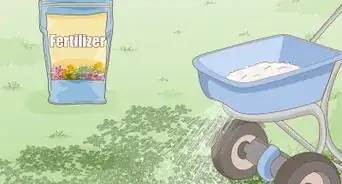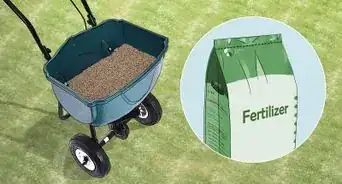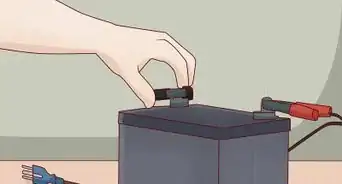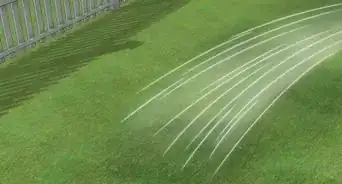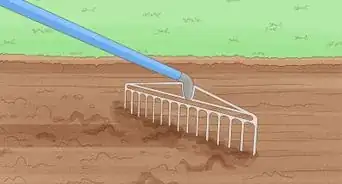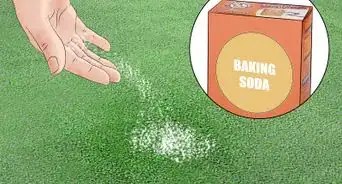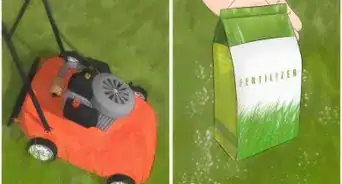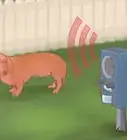This article was co-authored by Jeremy Yamaguchi. Jeremy Yamaguchi is a Lawn Care Specialist and the Founder/CEO of Lawn Love, a digital marketplace for lawn care and gardening services. Jeremy provides instant satellite quotes and can coordinate service from a smartphone or web browser. The company has raised funding from notable investors like Y Combinator, Joe Montana, Alexis Ohanian, Barbara Corcoran and others.
There are 7 references cited in this article, which can be found at the bottom of the page.
wikiHow marks an article as reader-approved once it receives enough positive feedback. In this case, several readers have written to tell us that this article was helpful to them, earning it our reader-approved status.
This article has been viewed 726,447 times.
Overseeding is one of the most important tasks involved in growing a healthy, lush lawn. While fertilizing your lawn is important, grass plants slow down their rates of reproduction after a few years. Over time, lawns that have not been overseeded will grow thin and unhealthy, making it much easier for weeds to overtake the lawn. Overseeding can be time-consuming if you have a large lawn, but it is not difficult, and the results are well worth it the effort.
Steps
Dethatching and Loosening
-
1Choose the right time of year to overseed. Arguably the best time to overseed is during September, or at least six weeks before temperatures reach freezing or there is an overnight frost.[1] If you can't overseed in September, overseed in early spring.
- Grass seed grows and germinates best when daytime temperatures are around 50°F (10°C). Germination will not take place if overnight temperatures create heavy frost.
- Allow at least one to three weeks for the seeds to germinate. You will then want to allow the grass seed a few weeks to get rooted before a frost.
-
2Manage weeds. If weeds are present, you will need to spray your lawn with a weed killer at least two weeks before you begin your project.[2] Choose a broadleaf weed killer with a 2-4-D base, which will only kill the weeds and not your grass.Advertisement
-
3Mow your existing lawn. Mow your lawn down to a height of 1 to 1 1/2 inches (2.54 to 3.81 cm) in order to minimize competition from grasses already established in your lawn. Mowing the lawn short will also help keep grass seeds from getting trapped in tall grass and will allow more sunlight to reach the new seedlings.
-
4Rake up the thatch and grass clippings. Thatch is a layer of mostly dead organic matter on the top of the soil.[3] You should also remove all grass clippings after mowing your lawn. A heavy layer of thatch or cut grass will keep seeds from germinating, as seeds need to be in direct contact with the soil in order to germinate.
- If you want to overseed a pre-existing lawn, cut the lawn shorter than normal, and rake the lawn to loosen the top layer of soil.[4]
- This will prepare it for the seed.[5]
- Normally, thatch is beneficial until it becomes thicker than 1 inch (2.5 cm).[6]
- Go over the top of your soil lightly with a thatch rake. This process is called "dethatching." If you can't find a thatch rake, you can use a leaf rake, although you may have to rake a little harder in order to remove the thatch.
- You may be able to rent a gas-powered dethatching machine from your local hardware rental center. This will save you a lot of time and hard labor.
-
5Loosen the soil using the most appropriate method based on the compactness of your soil. Options for loosening the soil include roto-tilling, aerating, heavy raking, or using the dethatching machine.
- Although roto-tilling is common practice when seeding a new lawn, it is also helpful for overseeding. The only difference between roto-tilling before overseeding and before planting a new lawn is the depth: overseeding requires only tilling about 1 or 2 inches into the soil, while new lawns require 4 to 6 inches.
- Aerate the soil using a broadfork, being careful not to break the underlying structure of the soil too much.[7] Breaking the soil open hurts the root structure of the existing grass and gives new weeds a chance to invade.
- If you have a large area to aerate, consider renting a gas-powered aerator.
Prepping the Soil
-
1Conduct a soil test to determine the pH of your soil. The ideal pH level is between 6.0 and 6.8. If you don't know how to perform a pH test, you have two options:
- You can buy a kit and perform the test yourself, according to direction on the labeling.
- You can hire a professional or ask your local city to perform a pH test for you.
- While this step is not essential to overseeding, it can mean the difference between a successful project or a waste of your time and hard work. You can risk skipping this step, but it is usually worth it in the long-run.
-
2Apply lime to your lawn if necessary. Lime will help balance out the pH, if necessary. Carefully follow the instructions on the packaging to determine the amount of lime needed based on the pH and the size of your lawn.
-
3Top-dress the soil with additional compost. Topdressing is the process of adding a thin layer of compostable material to the top of the lawn. The compost will help the seeds germinate and give the seedlings added nutrients to help them thrive. Look for enriched soil, which contains compost and other necessary nutrients, at a local home improvement store.[8]
- Lay a very thin layer of compost over the entire surface of the lawn. Too little is better than too much. Too much compost and your existing grass will effectively be buried under compost and die.
- Spread the compost out evenly over the entire surface of the lawn with a rake, preferably a thatch rake. Make sure that compost does not remain on the top of the grass. Remember to rake lightly when spreading the compost with your rake.
Spreading and Nurturing the Seed
-
1Spread grass seed evenly over the entire lawn. Use the amount specified on the seed packaging, based on the size of your lawn. To seed, you can either use a rotary spreader, a drop spreader, a hand spreader, or spread by hand.
- Make sure you choose a variety of seed that blends nicely with your existing lawn. Bermuda grass might be great, but it probably doesn't blend all that nicely with Fine Fescues.
- It's best to stay away from cheaper brands of seed. You really get what you pay for. If you decide to economize too much, your lawn may carry the telltale sign.
-
2Lightly rake the newly seeded area to help the seeds settle on the soil. Remember that any seeds that do not come into direct contact with the soil will not germinate.
-
3Apply a slow-release nitrogen fertilizer. Make sure you use a fertilizer that's appropriate for your specific lawn conditions, as indicated by the soil sample results.
- Put a light layer of topdressing over the seeds. Use the back of a leaf rake and lightly rake or tamp the topdressing.
- To prepare the soil before overseeding a lawn, you can put a thin layer of enriched soil over the existing soil. It provides better germination than the native, already existing soil.[9]
-
4Water the lawn completely immediately after overseeding. Continue to water the lawn frequently, three to four times daily for at least the first several weeks to ensure proper germination — the key is to keep the seeds moist.[10] Never let the seeds get completely dried out. Once the grass seed is firmly established, water the lawn for longer periods less frequently.
- In the beginning, it helps for the seeds to be moist or damp almost around the clock. This will help them germinate. After they have germinated, too much water can eventually kill the seedlings.
-
5Apply quick-release nitrogen fertilizer. Use a quick-release fertilizer at a rate of about 1 lb (.45 kg) per 1,000 square feet about five weeks after the seeds have germinated. Spread another application of quick-release nitrogen fertilizer six weeks later.
- Do not overuse the nitrogen fertilizer. Too much nitrogen can burn the new germination and seedlings.
-
6Mow the lawn once it reaches 2 to 3 inches (5.08 to 7.62 cm). Continue to mow the lawn to a height of 2 inches (5.08 cm) for the remainder of the season.
Expert Q&A
Did you know you can get expert answers for this article?
Unlock expert answers by supporting wikiHow
-
QuestionCan I just put grass seed on top of soil?
 Jeremy YamaguchiJeremy Yamaguchi is a Lawn Care Specialist and the Founder/CEO of Lawn Love, a digital marketplace for lawn care and gardening services. Jeremy provides instant satellite quotes and can coordinate service from a smartphone or web browser. The company has raised funding from notable investors like Y Combinator, Joe Montana, Alexis Ohanian, Barbara Corcoran and others.
Jeremy YamaguchiJeremy Yamaguchi is a Lawn Care Specialist and the Founder/CEO of Lawn Love, a digital marketplace for lawn care and gardening services. Jeremy provides instant satellite quotes and can coordinate service from a smartphone or web browser. The company has raised funding from notable investors like Y Combinator, Joe Montana, Alexis Ohanian, Barbara Corcoran and others.
Lawn Care Specialist
-
QuestionDo you use a weed and feed before you overseed or after?
 Anthony "TC" WilliamsAnthony "TC" Williams is a Professional Landscaper in Idaho. He is the President and Founder of Aqua Conservation Landscape & Irrigation, an Idaho Registered Landscape Business Entity. With over 21 years of landscaping experience, TC has worked on projects such as the Idaho Botanical Garden in Boise, Idaho. He is a Idaho Registered Contractor and a previously Licensed Irrigator in the State of Texas.
Anthony "TC" WilliamsAnthony "TC" Williams is a Professional Landscaper in Idaho. He is the President and Founder of Aqua Conservation Landscape & Irrigation, an Idaho Registered Landscape Business Entity. With over 21 years of landscaping experience, TC has worked on projects such as the Idaho Botanical Garden in Boise, Idaho. He is a Idaho Registered Contractor and a previously Licensed Irrigator in the State of Texas.
Experienced Landscaper
-
QuestionIs a very light application of peat moss beneficial to an over-seeded lawn?
 Anthony "TC" WilliamsAnthony "TC" Williams is a Professional Landscaper in Idaho. He is the President and Founder of Aqua Conservation Landscape & Irrigation, an Idaho Registered Landscape Business Entity. With over 21 years of landscaping experience, TC has worked on projects such as the Idaho Botanical Garden in Boise, Idaho. He is a Idaho Registered Contractor and a previously Licensed Irrigator in the State of Texas.
Anthony "TC" WilliamsAnthony "TC" Williams is a Professional Landscaper in Idaho. He is the President and Founder of Aqua Conservation Landscape & Irrigation, an Idaho Registered Landscape Business Entity. With over 21 years of landscaping experience, TC has worked on projects such as the Idaho Botanical Garden in Boise, Idaho. He is a Idaho Registered Contractor and a previously Licensed Irrigator in the State of Texas.
Experienced Landscaper
Things You'll Need
- Lawn mower
- Rototiller or aerator, if needed
- Sturdy rake
- Soil test
- Lime
- Slow-release nitrogen fertilizer
- Quick-release nitrogen fertilizer
- Grass seed
- Seed spreader
- Garden hose
- Gas-powered dethatching machine (optional)
References
- ↑ http://gardening.yardener.com/Overseeding-Lawns
- ↑ Keith Souza. Home Improvement Specialist. Expert Interview. 20 August 2021.
- ↑ http://urbanext.illinois.edu/lawnchallenge/lesson5.html
- ↑ Jeremy Yamaguchi. Lawn Care Specialist. Expert Interview. 21 January 2020.
- ↑ Jeremy Yamaguchi. Lawn Care Specialist. Expert Interview. 21 January 2020.
- ↑ Jeremy Yamaguchi. Lawn Care Specialist. Expert Interview. 21 January 2020.
- ↑ Keith Souza. Home Improvement Specialist. Expert Interview. 20 August 2021.
- ↑ Jeremy Yamaguchi. Lawn Care Specialist. Expert Interview. 21 January 2020.
- ↑ Jeremy Yamaguchi. Lawn Care Specialist. Expert Interview. 21 January 2020.
- ↑ Keith Souza. Home Improvement Specialist. Expert Interview. 20 August 2021.
- http://www.savvygardener.com/Features/lawn_overseeding.html
- http://yardener.com/YardenersPlantHelper/LawnCareForYardeners/FixingLawns/OverseedingLawns
- http://www.allaboutlawns.com/lawn-maintenance-care/planting-and-repair/overseeding-your-lawn.php
About This Article
To overseed a lawn, wait until early autumn or spring. Also, make sure you get rid of any weeds and mow your lawn before you get started. You should also spread a very thin layer of compost over your lawn, which will help the new seeds germinate. Once you've prepared the lawn, spread the grass seeds evenly over it and lightly rake the seeds into the soil. Thoroughly water your lawn immediately after you lay down the new grass seed, and continue to water it 3-4 times a day until the new grass is established. To learn more from our Professional Landscaper co-author, like how to check the pH of your soil before seeding it, keep reading the article!



